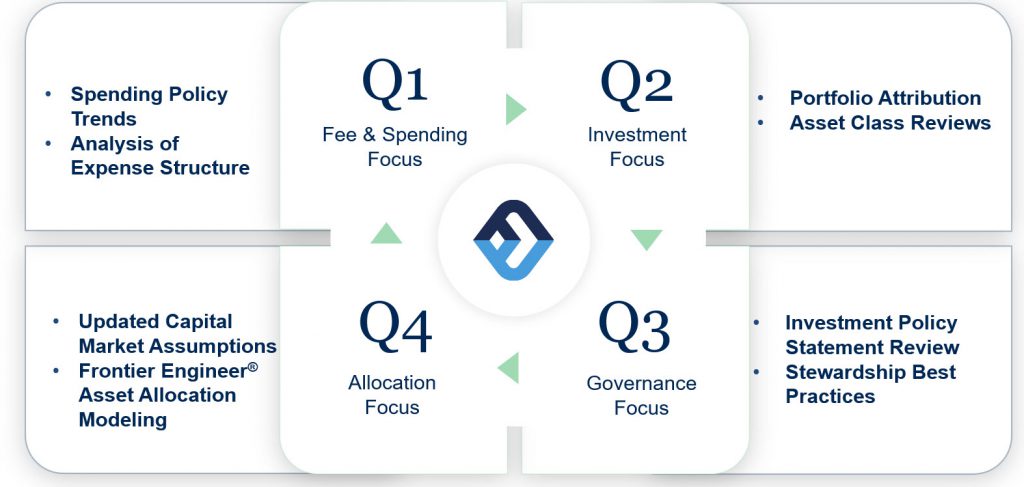One of the most important factors in ensuring the long-term success of a charitable organization is committing to a strong governance process. Particularly as it relates to investment results, all too often stewards of nonprofit assets get mired in the short-term, asking ephemeral questions like: What was our performance for the quarter? How did our endowment/foundation perform relative to the benchmark? How did we perform when compared to our peers?
While these matters are not insignificant, they can cloud the big picture. Rather, nonprofit leaders tasked with overseeing perpetual investment programs (such as endowment assets and foundations) must remain focused on long-term strategy. By adhering to a disciplined governance process, nonprofit committees and boards are better able to meet their fiduciary obligations and ensure the long-term health of the organization.
A calendar-based approach to governance, like the one displayed below that we implement on behalf of our clients, provides the discipline and structure necessary to establish and maintain strong governance. This fiduciary governance calendar provides documentation that creates a Fiduciary Trail®. Over the course of a calendar year, this disciplined approach can help good stewards be certain that important fiduciary duties are addressed.

Begin With Overall Financial Goals for Your Charitable Organization
Reviewing and re-underwriting a portfolio’s asset allocation profile on an annual basis is an important part of a structured governance process. This review includes analysis of risk and return expectations considering each organization’s stated return objectives (once again, we find ourselves referring back to one of the Three Levers – specifically to the concept of required return).
Since asset allocation is often considered the primary determinant of long-term investment results, it is critical that investment committees step back from discussions focused on short-term results and move forward by formally reviewing long-term expectations and portfolio positioning.
Focusing on fees and spending policy are other important aspects of governance. Once again, there is a connection to the Three Levers – fees and spending make up the outflows. Being thoughtful and strategic with regards to spending and fees is crucial, particularly in challenging environments like the one we face with the COVID-19 pandemic, or any crisis.
Committees should periodically and objectively analyze which aspects of an investment program are working and which are not. Questions to ask include:
What additional asset classes that we should be considering?
Are there any asset classes that we should consider eliminating?
How has our asset allocation positioning impacted historical performance?
Has our manager selection been additive, or has it detracted?
Investment committee members must think through these key questions and review them with their respective advisors regularly. Addressing these issues helps not only to evaluate historical results but also to position the portfolio appropriately for the future.
Thoughtfully Update Investment Policies
A strong and disciplined governance process requires sound governing documents. Concerning the investment program, the Investment Policy Statement (IPS) is the principal governing document. The IPS should serve as the blueprint for management of your endowment fund or foundation asset pool, and it is critical that investment committee members and all other relevant advisors be familiar with the IPS, strictly adhering to it. The IPS will generally include the following:
- Guidance regarding allowable asset class exposures
- Rebalancing procedures
- Return objectives
These aspects of the IPS help keep responsible parties focused on the long-term strategy of the investment program. Good governance calendars often call for review and approval of the IPS annually.
And good governance of a nonprofit extends beyond investment strategy. Nonprofit leadership should be thoughtful about the number of members on the board and on underlying committees. A nonprofit board (or an underlying committee) that is too large may lead to disengagement, as board members may feel that their voice is unnecessary or gets lost in the crowd. In contrast, a small board (or committee) may lack perspective and varying viewpoints, and individual obligations may become too burdensome when a group is too small.
In addition, the nonprofit board must include individuals with diverse areas of expertise, backgrounds and points of view. Term limits are another important consideration with board governance. Term limits should be long enough to allow for institutional memory and consistency of approach but must not be so long as to prevent “new blood” from joining the board and offering fresh perspectives. Finally, board and committee leadership must be active and engaged, and this includes the nonprofit leaders being open to new ideas and encouraging of discussion.
In addition to the Investment Policy Statement, which provides the blueprint for management of a charitable organization’s investment program, other governing documentation should be equally robust. A formal written mission statement ensures that the board remains focused on what is essential to the organization. Board bylaws must be up-to-date, and all board members must comply. Meeting minutes should be circulated in a timely fashion and kept on file for historical reference. Making all relevant documentation available and accessible establishes a strong culture of governance.
Three Steps to Building a Culture of Strong Nonprofit Governance
- Create (and adhere to!) a checklist of responsibilities and obligations:
We recommend the calendar-based approach for added structure and organizational accountability.
- Be thoughtful about the construction of your committee or board and ensure that members have suitable characteristics. You should:
- Build diversity of background, expertise and opinion on the board/committee.
- Optimize size by making sure the board/committee is neither:
- Too large as to dissuade engagement
- Too small as to lack diversity and overburden individual members
- Maintain term limits that allow for both institutional memory and fresh perspectives.
- Have formal governing documents on file—and refer to them regularly. Such documents include:
- Investment Policy Statement
- Mission statement
- Board bylaws
- Strategic plan
- Meeting minutes
The information contained herein is confidential and the dissemination or distribution to any other person without the prior approval of Fiducient Advisors is strictly prohibited. Information has been obtained from sources believed to be reliable, though not independently verified. Any forecasts are hypothetical and represent future expectations and not actual return volatilities and correlations will differ from forecasts. This report does not represent a specific investment recommendation. The opinions and analysis expressed herein are based on Fiducient Advisor research and professional experience and are expressed as of the date of this report. Please consult with your advisor, attorney and accountant, as appropriate, regarding specific advice. Past performance does not indicate future performance and there is risk of loss.




